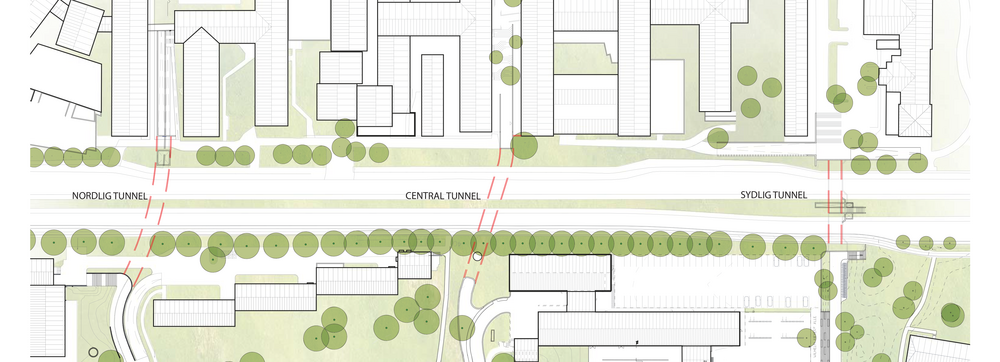- Education
-
Research
Current research
Talent
-
Collaboration
Businesses
Government agencies and institutions
Alumni
-
About AU
Organisation
Job at AU
The process of opening up a new underground passage at the northern end of the University Park is now beginning. The passage will literally connect the yellow and red buildings.
2020.09.16 |

The photo shows what the transition between the yellow and red bricks will look like in the new passages connecting the University Park and the University City below Nørrebrogade. Visualisation by C. F. Møller.
2022 will see the University Park and the University City physically connected by a new passage near the Nørrebrogade-Nordre Ringgade intersection.
Brian Bech Nielsen, rector of Aarhus University, sees the passage as an important link to achieve the sense of a common campus we are looking for:
"In the coming years, more and more students and employees will be moving into the University City. The physical link between the University Park and the University City is therefore crucial for us to achieve a strong, unified campus environment and to continue to develop close collaboration between our various subjects. The University Park and the University City must merge to become a single campus.”
The northern passage is one of three passages that will connect the University Park with the University City. The second passage already exists – at the southern end of the University Park down towards the Nørrebrogade-Nørregade intersection – and will be renovated over a number of years. The third passage will be completed in 2025 with an entrance in the centre of the University Park. See the location of the passages in the illustration below.
All passages will have a bike lane and a footpath, so that both pedestrians and cyclists can move easily and safely between the University Park with its yellow brick buildings and the red University City.
The fusion of the red and yellow buildings will also resonate inside the passages, says Charlotte Lyngholm Bom, programme manager for physical campus development at Aarhus University.
Using the architecture to create coherence has been very important. The bricks at the entrance to the passage from the University Park will be the classic AU yellow bricks, and through the passage the yellow bricks will slowly blend with the red bricks used in the buildings in the University City. When the passage opens to the University City, all the bricks are red," she explains, stressing that moving between the University Park and the University City will be a beautiful visual experience.
The architectural expression must therefore match the existing buildings in the University Park and be integrated as a natural part of the surroundings.
In developing the passages, the university also attaches great importance to the safety and security of users – both pedestrians and cyclists.
"We’re very keen to find solutions that are both sustainable and provide safety and security for everyone using the passages. One of the things we’ve looked at is how we can get cyclists to slow down," says Charlotte Lyngholm Bom.
The task of preparing and opening up the northern passage will now be put out to tender, and construction work is expected to begin in November.
If you have any questions about the passages, you are welcome to contact Charlotte Lyngholm Bom cl@au.dk, programme manager for physical campus development, Campus 2.0, at Aarhus University.

Location of the three underground passages. The northern passage is expected to be ready by 2022, the middle passage by 2025, and the southern passage already exists. Visualisation by C. F. Møller.